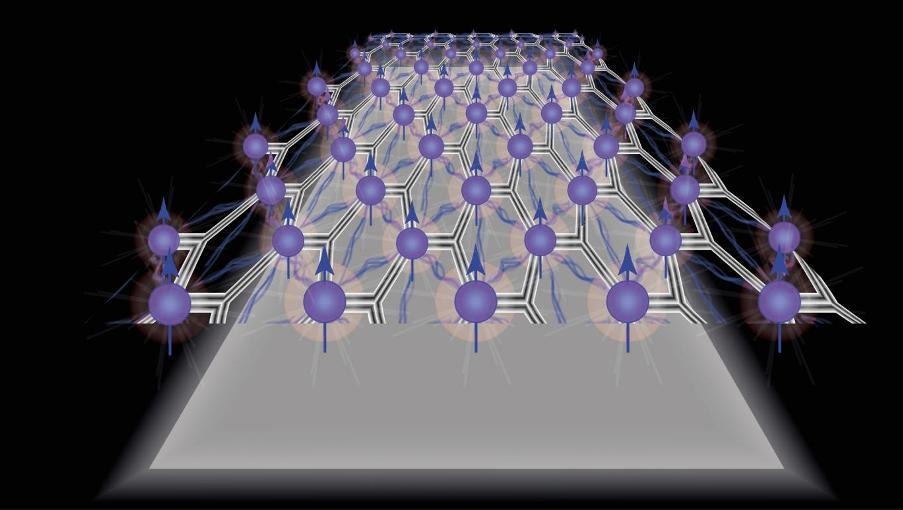Mar 12 2019
The spin alignment of free electrons within a two-dimensional material has been revealed by physicists at the University of Basel.
 In a two-dimensional layer of molybdenum disulfide, the electron-electron interaction (blue threads) force the spins of the electrons (violet spheres) to align. (Image credit: Department of Physics, University of Basel)
In a two-dimensional layer of molybdenum disulfide, the electron-electron interaction (blue threads) force the spins of the electrons (violet spheres) to align. (Image credit: Department of Physics, University of Basel)
They have reported their observation of spontaneous spin polarization in the most recent edition of Nature Nanotechnology, which cannot take place in ideal two-dimensional materials as stated by a well-established thesis from the 1960s.
Two-dimensional materials are the focus of a number of investigations. Since they have a thickness of a few atomic layers, their physical properties differ from their three-dimensional counterparts. Graphene, a single layer of carbon atoms organized in a honeycomb pattern, shows promise in offering completely new applications due to its extraordinary electronic properties and is the best-known example in this class of ground-breaking materials.
A team examining two-dimensional materials that are also appropriate for optical applications is led by professor Richard Warburton from the Department of Physics and the Swiss Nanoscience Institute of the University of Basel. One predominantly promising candidate is a single monolayer of molybdenum disulfide (MoS2), since this material has a band gap—unlike graphene—and thus it can emit light on excitation.
All in the Same Direction
Presently, in the latest studies of two-dimensional molybdenum disulfide layers, doctoral students Jonas Roch and Nadine Leisgang have made an extremely unexpected discovery. They packed the MoS2 layer with free electrons and subsequently subjected it to a weak magnetic field.
As a result, the intrinsic angular momentum (spin) of all free electrons was made to point in the same direction, and the spin could be “switched” to the other direction by reversing the magnetic field. This phenomenon, referred to as “spontaneous spin polarization,” was completely unexpected because a theorem from the 1960s obviates the possibility of spontaneous spin polarization in an ideal two-dimensional material.
Where does the spin polarization come from? The electrons are interacting with one another, and molybdenum disulfide also exhibits a very weak spin-orbit coupling. These two factors presumably have a massive influence on the system.
Jonas Roch, Doctoral Student, University of Basel.
The formulation of the 1966 theorem had supposed a lack of spin-orbit interaction.
The results show how exciting experimental physics can be, and how we’re constantly learning new things about two-dimensional materials.
Professor Richard Warburton, Department of Physics and Swiss Nanoscience Institute, University of Basel.
The work is supported by the Swiss National Science Foundation, the Swiss Nanoscience Institute, the National Center of Competence in Research QSIT, and the PhD school Quantum Computing and Quantum Technology of the Departement of Physics at the University of Basel.